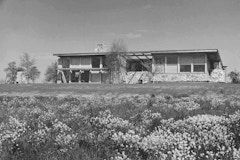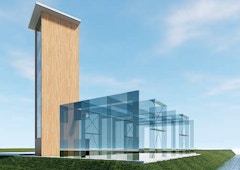
179 results
-
 Building design criteria requires that government buildings be designed for a variety of extreme loads including blast, hurricane, and impact…
Building design criteria requires that government buildings be designed for a variety of extreme loads including blast, hurricane, and impact… -

Adaptable Glazing Shields
- Paper by Anas Al Kassas,
Today, about 40% of all buildings in the U.S. still have single-pane windows, and ~70% of the existing building stock is estimated to suffer from… -
North Capitol Building Case Study
- Paper by Jeremy Simmonds, Project Manager at KEPCO+ Bruce Knaphus, President
The Utah State Capitol North Building, currently under construction, features 80,000 SF of classically designed cubic granite detailing, including… -

Fire Safety in High Rise Exterior Facades
- Paper by Angela M. Ogino,
One of the most complex yet least understood areas where fire can spread is at the perimeter of a building. Fire can not only spread from… -

Prefab Facades – from Prototype to Product?
- Paper by Lisa Rammig · Andrea Zani · Tim Murphy
Building envelopes are not only an immediately visible part of the building, they have also become a major factor both for cost and performance of
-

Reconfigurable Terracotta Facade
- Paper by Jin Young Song · Dan Vrana · Jonathan Hopp · Shawn Murrey · Jiatao Wu · Jongmin Shim
The traditional building facade as a permanent construction does not actively respond to the differing needs from varying weather conditions.
-
Interstitial condensation risk assessment
- Paper by Jelle Langmans · Piet Houthuys · Wout Parys · Staf Roels
The development of methods to predict and control moisture accumulation in building envelopes has always been a key element in building science.
-

Feasibility of Measuring Stress in Glass with a SCALP
- Paper by Nabhajit Goswami, Student Stephen M Morse, P.E., Ph.D., Assistant Professor, Civil and Environmental Engineering Assistant Professor, Mechanical Engineering-Engineering Mechanics
The SCALP device is designed to measure the residual compressive surface stress of glass. As the SCALP does not rely on the birefringence properties… -
Honing the Craft
- Paper by Patrick Delorey, Digital Fabrication Manager
Finishing of custom-fabricated architectural façade components represents one of the most significant components to their cost. Manually driven… -

Establishing a Life Cycle Assessment Methodology for Innovative Facade
- Paper by Vikki Lew
Life cycle assessment was introduced in the 1970s as an analytical tool to quantify the environmental impact of a product, process, or service.
-

Orientation Specific Solar Control
- Paper by Clifton Fordham
During the postwar era, and before the universal adoption of air-conditioning in the United States, leading architects participated in the design of
-

All-Glass Bearing Facades
- Paper by Erwin ten Brincke
The Green Village at the TU Delft is a living lab for sustainable innovations. The Co Creation Centre (CCC) will be their new meeting center (13.5 x
-
Comparison of Historical Weathered Annealed Glass Failure Data to ASTM E1300
- Paper by Nabhajit Goswami; Student, ngoswami@mtu.edu Stephen M Morse; Assistant Professor, Civil and Environmental Engineering Assistant Professor, Mechanical Engineering-Engineering Mechanics Michigan Tech University, smmorse@mtu.edu
Historical published weathered annealed failure data consisting of 13 samples were collected and glass failure prediction model surface flaw… -
Facades Education in the United States
- Paper by Ajla Aksamija, PhD, Professor and Distinguished Chair for Resilient Places Suncica Milosevic, PhD Candidate Gabrielle Brainard, Associate Principal Timothy Brown, Associate Professor
This paper presents the results of a research study, outlining the state of facades education at higher-education institutions across the United… -

Daylighting Post-Occupancy Evaluation Study
- Paper by Jae Yong Suk, Ph.D., Helena Zambrano, AIA,
Daylighting is a key strategy to energy efficiency and improved occupant comfort, health, and productivity in buildings. However, providing desired… -

Active and Energy Autonomous Window
- Paper by Annalisa Andaloro · Leire Minguez Hilera · Stefano Avesani
Reducing GHG emissions related to energy use in buildings is a prominent obligation given their impact in terms of climate change. In this light,
-

The Seismic Capability of Curtainwalls
- Paper by Peter Lalas MIEAust CPEng NER APEC Engineer IntPE(Aus)
The testing of aluminum/glass curtainwalls for seismic capability, mainly inter-story drift, has been carried out on many curtainwalls over the last
-

The Craft of Building Enclosures
- Paper by Christopher Payne, AIA, LEED AP
This paper will provide case studies of two high-performance building envelopes in the San Francisco Bay Area where the fabrication of bespoke façade
-
Insulating Glass Unit Gas Loss
- Paper by Mark K. Schmidt, M.Eng., S.E. · Stephen M. Morse, PhD, P.E.
Concerns over time-dependent argon permeation through the perimeter edge seals of insulating glass units (IGUs) led the authors to utilize two
-

Paul Rudolph's Christian Science Building
- Paper by Scott Murray,
This paper presents new historical research on the concrete facade of an important but relatively unknown and now demolished building by the American…